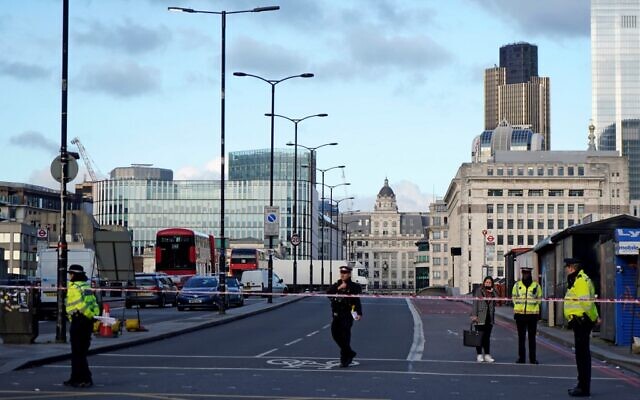Terror group says suspect Usman Khan, 28, a convicted terrorist out on parole who killed two in stabbing rampage, was acting on its behalf
By TOI STAFF and AGENCIES
The Islamic State terror group on Saturday said that the London Bridge terror attack a day prior was carried out on its behalf.
The terror organization said Usman Khan, a 28-year-old convicted terrorist released early from prison last year who stabbed two people to death during a rampage on Friday, was acting in the group’s name, falling short of claiming direct responsibility.
The Islamic State issued the announcement on its news agency Amaq published on messaging app Telegram. The group said Khan was “responding to calls to target the nationals of coalition countries,” in reference to a call by former IS spokesperson Abu Muhammad al-Adnani to followers around the world to carry out acts of violence using any means possible.
The New York Times’ Rukmini Callimachi, who has reported extensively on IS, said on Twitter that the phrase is lifted directly from a speech by al-Adnani, who was killed in an airstrike in 2016. Callimachi cautioned that some of the deadliest attacks in the West in recent years had been “inspired” by IS propaganda or carried out “on its behalf” including the July 14, 2016 truck-ramming attack in Nice in which over 80 people were killed and the attack a month prior in an Orlando nightclub that killed over 45.
Khan killed two people and injured three others in his attack Friday before he was pursued and detained by bystanders, then fatally shot by police officers at the scene. He wore what turned out to be a fake explosives device during the spree.
The attack began at a Cambridge University conference on prisoner rehabilitation as part of a program called “Learning Together” at Fishmongers’ Hall at the north end of London Bridge. Kahn is said to have started ranting and waving knives at the conference as others tried to intervene. He killed Jack Merritt, 25, a course leader of the program and a woman who has not yet been named.
Bystanders helped disarm and restrain Khan after the killings until police arrived. Video footage showed a number of people, one with a fire extinguisher and another armed a narwhal tusk, taking Khan to the ground before the arrival of police. The man with the tusk was identified by The Times as Luckasz, a chef from Poland who worked in the hall’s kitchen.
London police counterterrorism chief Neil Basu said Saturday that authorities believe “the attack began inside before he left the building and proceeded onto the bridge.”
Khan had been conditionally released from jail last December after serving less than half of a 16-year sentence for terrorism. Police said Khan was convicted in 2012 of terrorism offenses including an al-Qaeda inspired plot to bomb the London Stock Exchange in 2010. He was released in December 2018 “on license” which meant he had to meet certain conditions or face recall to prison.
Several British media outlets reported that he was wearing an electronic ankle bracelet at the time of Friday’s attack.
British media, citing security sources, reported on Friday that Khan had links to Islamic extremist groups and was known to the UK’s MI5 intelligence agency.
Khan had been living in the Staffordshire area of central England, police said. Authorities were carrying searches in Staffordshire in connection to the attack.
The British government on Saturday vowed a “full review” as the justice system came under intense public scrutiny following the announcement that Khan was a convicted terrorist.
UK PM Boris Johnson, who visited the scene of the attack Saturday, said those “who have committed terrorist offenses” should not be granted early release.
The British Parole Board in a statement said it had no involvement in the release of Khan “who appears to have been released automatically on license [as required by law] without ever being referred to the Board.”
Khan had been convicted in 2012 as part of an al-Qaeda linked group that was accused of plotting to target major sites including Parliament, the US embassy and individuals, including Prime Minister Boris Johnson, then the mayor of London, the dean of St. Paul’s Cathedral in London and two rabbis.
Khan admitted to a lesser charge of engaging in conduct for the preparation of acts of terrorism. He had been secretly taped plotting attacks and talking about martyrdom as a possibility.
Khan and his accomplices had links to radical preacher Anjem Choudary, one of the highest-profile faces of radical Islam in Britain. A mobile phone seized at the time contained material related to a banned group that Choudary founded. The preacher was released from prison in 2018 but is under heavy surveillance and a curfew.
Several people who attended Choudary’s rallies when he was under no controls have been convicted of attacks, including the two al-Qaeda-inspired killers who ran over British soldier Lee Rigby and stabbed him to death in 2013.
